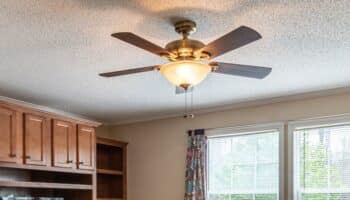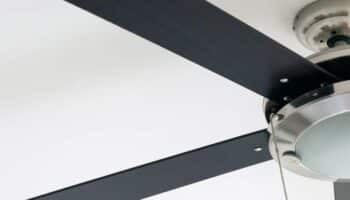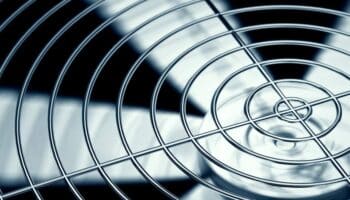We've independently reviewed this article to make sure it's as accurate as we can make it.
To find out more about our article creation and review process, check out our editorial guidelines.
Is your ceiling fan refusing to turn off?
You’re not alone! Being unable to turn off your ceiling fan can be frustrating, especially when you’re already cold.
But don’t worry; I’m here to help.
If your ceiling fan won’t turn off, there’s probably an issue with the remote, chain, or some of the internal components. Please turn off the power before you fix the unit to prevent electrical hazards.
Read on to get your ceiling fan working again!
5 Steps To Fix a Ceiling Fan That Won’t Turn Off
In this section, I’ll guide you through the different steps you must follow to fix a ceiling fan that won’t turn off.
Keep in mind that you’ll need a screwdriver, access to the circuit breaker box, and the manufacturer’s manual.
Are you ready? Let’s dive in!
#1 Check the Remote
When I see a ceiling fan that won’t turn off, I always check the remote.
You see, if the batteries are dead or the remote is broken, you won’t be able to control your ceiling fan, and it will stay turned on.
Take a look at the remote control and try pressing a button. Do you hear a beep or get any movement at all? If not, you probably need to change the batteries.
Another way to check the batteries is by making sure the light on the remote blinks when you press a button. If it doesn’t blink, it indicates that the batteries are dead.
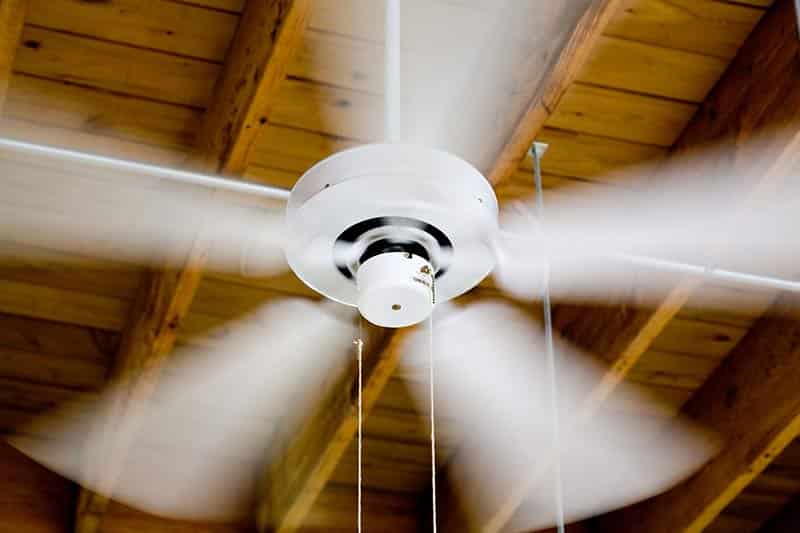
What happens if your remote control doesn’t have a light on it? There’s probably a button to control the light setting on the ceiling fan as well. See if the button allows you to change the light setting. Remember to replace the batteries if your ceiling fan light won’t turn off.
If you notice the remote is broken or damaged, please replace it with a new one.
If you want to get any replacement part – or see how much one would cost – click to enter your model number in the search bar below. Our partners at AppliancePartsPros stock almost every part with free guides on how to install them.

#2 Try the Switch in the Room
If your ceiling fan still refuses to turn off even after checking the remote, I recommend trying with the switch at the back of the room.
There is probably a light switch you can flip that will turn off the ceiling fan and the light fixture. If you flip the switch and nothing happens, try the other switches in the room.
For example, other lights in the ceiling could be controlled using different switches. If the other light fixtures are responding to the light switch, there is probably something wrong with the ceiling fan itself. However, if you can’t get the other lights to react to the light switches, then there is something wrong with the power flowing into the room.
In such cases, my usual advice is to call a certified electrician who can help you fix the electrical issue.
#3 Take a Look at the Chain
If you’ve narrowed down the source of the issue to the ceiling fan itself, then it is time to take a closer look at the individual components.
Most ceiling fans have a chain you can pull to adjust the settings. So, your fan could refuse to turn off due to a problem with the chain.
Start by pulling the chain to see if it changes the speed of the ceiling fan. You should feel the chain pulling a gear as you yank on it. If you do not get any friction or resistance when you pull the chain, the internal mechanism is probably faulty.
You must use a screwdriver to get inside the ceiling fan to examine what is happening closely.
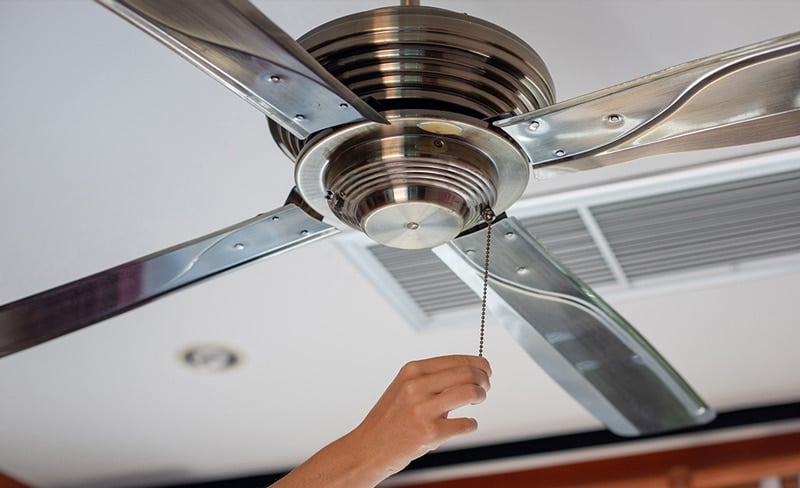
Note: If you notice the chain is broken or damaged, please reattach a new chain.
#4 Disconnect the Power to the Room
As mentioned above, if your ceiling fan won’t turn off with the chain, you’ll need to inspect the internal components.
Before working on the ceiling fan, you need to disconnect the power to the room. To do so, go to the circuit breaker box and remove all electricity flowing to that specific room of the house.

When looking at the circuit breaker box, there should be small labels for each room of the house. Find the label corresponding to that specific room, and disconnect the power.
It is important for you to always place safety at the top of your priority list. You do not want to get electrocuted when working on the ceiling fan!
#5 Analyze the Internal Components of the Fan
Now, it’s time to analyze the ceiling fan’s internal components to know why it’s refusing to turn off.
Once the power has been disconnected, remove the bottom of the ceiling fan so you can take a closer look at the internal components.
Look for any obvious signs of wear and tear. You’ll probably see a broken part that has to be fixed or spot burn markings that could indicate that an electrical component has shorted out.
Regardless, it is critical to think carefully about which parts are worth replacing. In my opinion, it’s best to compare the cost of the components that need to be replaced with your fan’s original price to determine if replacing the entire fan is more cost-effective.
Should I Call an Electrician?
If your ceiling fan refuses to turn off or is experiencing other issues, you’ve probably been wondering when it’s a good idea to call an electrician.
If you are ever uncomfortable working on your ceiling fan, contact a professional who can help.
It’s also a good idea to call a professional if your ceiling fan is brand-new and still under warranty. On the other hand, if the ceiling fan is very old, you’re probably better off replacing the entire unit.
Wrapping Up: Fixing a Ceiling Fan That Won’t Turn Off
Hopefully, now you know how to fix your ceiling fan issues.
Remember that if your ceiling fan won’t turn off, there’s probably an issue with the remote, chain, or internal components. Don’t forget that if you need help fixing your ceiling fan, you’ll need to reach out to a professional who can assist you.
Thank you so much for reading! If you found this post helpful, please check out our other related posts below.
Good luck.







